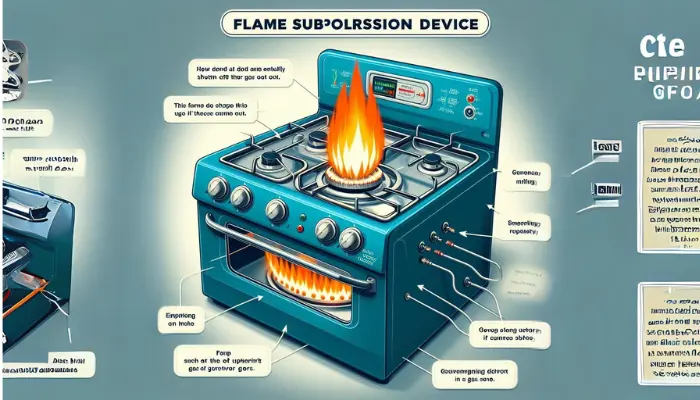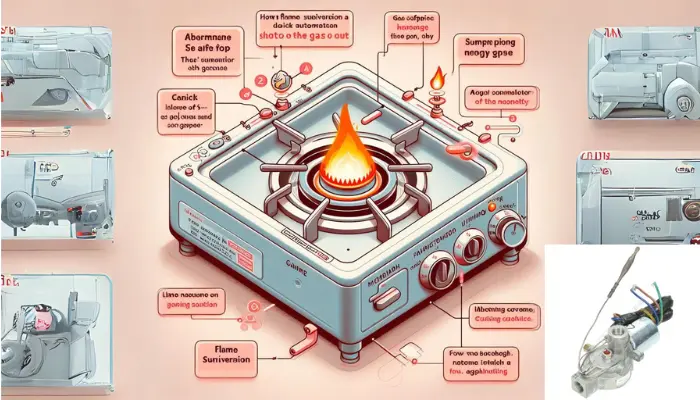Imagine this You smell a faint hiss from your gas stove, even though you turned it off. A tiny gas leak could be really dangerous! That’s where a flame supervision device (FSD) comes to the rescue. This little safety gadget is like a secret hero in your gas appliances, protecting your home from gas leaks. Let’s learn all about FSDs: what they are, how they work, and why they’re so important for safety.
Key Takeaways
- Flame supervision devices (FSDs) are crucial safety features that cut off gas flow if a flame goes out.
- They’re often used in gas stoves, ovens, boilers, and water heaters.
- Thermocouples are the most common type of FSD.
- FSDs are often required by law.
- Don’t attempt to fix a faulty FSD yourself — always consult a qualified technician.
What is a Flame Supervision Device?
In essence, a flame supervision device (FSD) is a safety mechanism designed to automatically cut off the gas supply to an appliance if the flame extinguishes unexpectedly. Whether it’s a draft blowing out the pilot light, a spill on the burner, or a temporary gas supply issue, an FSD acts as a safeguard against the potential buildup of dangerous, flammable gas.
Why are Flame Supervision Devices Important?
- Preventing Gas Leaks: Uncontrolled gas leaks pose a serious risk of fires and explosions. FSDs mitigate this hazard by swiftly halting the gas supply when a flame is no longer detected.
- Safety Regulations: Due to their vital safety function, FSDs are often mandated by law or building codes for new gas appliances.
- Peace of Mind: Knowing that your gas appliances have an FSD provides assurance, reducing the worry about potential gas-related accidents.

How Do Flame Supervision Devices Work?
There are several technologies used in flame supervision devices, but let’s focus on the most common and widely used one:
Thermocouple-Based FSDs
- The Thermocouple: This is the heart of the system. A thermocouple consists of two dissimilar metals joined together. When exposed to heat from a flame, it generates a small electrical voltage.
- Electromagnetic Valve: The thermocouple is connected to an electromagnetic valve that controls the gas flow. As long as there is a voltage from the thermocouple, the valve stays open allowing for gas to flow.
- Flame Failure: If the flame goes out, the thermocouple cools down rapidly, the voltage drops, causing the electromagnetic valve to close, shutting off the gas supply.
Types of Flame Supervision Devices
While thermocouples are most common, here’s a quick look at other types of FSDs:
Flame Rectification:
Some industrial settings use sensors that detect the electrical conductivity properties of a flame, shutting off the gas if those properties are no longer present.
Ultraviolet Sensors:
- In specialized applications where other methods are unsuitable, sensors that detect ultraviolet light emitted by flames can be used.
Reasons for Unexpected Flame Failure
Here’s a quick breakdown of why the flame in your gas appliance might give out, triggering the FSD:
- Drafts: Airflow near the appliance can extinguish the flame.
- Spills: Liquids can overflow and put out the flame.
- Gas Supply Issues: Temporary interruptions in your gas supply.
- Faulty FSD: Sometimes, the FSD itself can malfunction.

Signs of a Potential FSD Problem
- Difficulty lighting your gas appliance.
- Gas flame frequently going out.
- Clicking sounds from the appliance when the burners are off.
IMPORTANT: If you suspect a problem with your FSD, do not try to fix it yourself. Always call a qualified gas technician.
Troubleshooting Flame Supervision Device Issues
While a faulty FSD often means calling in a professional, there are some preliminary checks you can safely do:
- Check for obstructions: Ensure nothing is blocking the burner or interfering with the flame. Clean the burner area thoroughly if needed.
- Thermocouple position: In some cases, the thermocouple might become slightly misaligned. If it’s visually accessible and you are comfortable doing so, make sure the tip is positioned correctly in the flame path.
- Caution: Turn off the appliance and let it cool completely before attempting this.
- Rule out external factors: Check for drafts or recent spills that might have caused the flame to go out.
Important: If these basic checks don’t help, or if you feel unsure about any aspect, do not hesitate to call a qualified gas technician.
Replacing a Flame Supervision Device
FSDs, particularly thermocouples, can wear out over time. If a technician determines that your FSD needs replacement, here’s what you can generally expect:
- Diagnosis: The technician will identify the specific type of FSD in your appliance.
- Sourcing Parts: They’ll order the correct replacement part as needed.
- Installation: The old FSD will be carefully removed and the new one installed, ensuring proper connections and calibration.
- Testing: The technician will verify that the new FSD works correctly and the gas system is safe.
How to test a flame failure device
Testing a flame failure device (FSD) typically requires some technical know-how. Here’s a simplified overview, but always consult your appliance manual or a qualified technician for specific instructions:
- Identify the FSD Type: Thermocouples are the most common. Others include flame rectification and UV sensors.
- Prepare a Multimeter: You’ll need a multimeter that measures microamps (for thermocouples) or voltage as relevant to your FSD type.
- Safety First: Turn off the gas supply and let the appliance cool completely.
- Locate and Disconnect: Find the FSD and carefully disconnect the wires.
- Set up and Measure: Connect the multimeter to the FSD leads. Simulate the presence of a flame (heat for thermocouples) and observe the readings. Your appliance manual should specify the expected values.
Cost Considerations for Flame Supervision Device Issues
The cost of addressing an FSD issue depends on several factors:
- Diagnosis: Initial evaluation fees from a technician.
- Parts: The price of the replacement FSD varies depending on the type and model of your appliance.
- Labor: Technicians typically charge hourly rates.
- Complexity: In some cases, there might be additional work involved beyond simply replacing the FSD.
Maintaining Your Gas Appliances for Safety
- Regular Servicing: Schedule annual inspections by a qualified technician to check for wear and tear on your FSD, as well as other components of your appliance.
- Follow Manufacturer Instructions: Proper usage as per your appliance manual helps ensure all components, including the FSD, function as intended.
- Don’t Ignore Warning Signs: Clicks, difficulty lighting, or frequent flame-outs should be promptly addressed by a professional.
Additional Notes
- Older Appliances: Some very old gas appliances might not have an FSD. Consider upgrading for enhanced safety.
- Carbon Monoxide Detectors: While FSDs protect against gas leaks, carbon monoxide detectors are crucial for alerting you to incomplete combustion, which can be lethal.
Frequently Asked Questions (FAQ’S)
Are FSDs required on all gas appliances?
While not universal, many gas appliances, particularly newer models, are legally required to have FSDs. Building codes and regulations in your area will determine the specifics.
Can I install an FSD myself?
It is strongly advised against. Working with gas systems requires specialized training and carries significant safety risks. Always consult a qualified gas technician.
How long does an FSD typically last?
Thermocouples, the most common FSD, can have varying lifespans. However, with normal wear and tear, they often last several years and could function reliably for a decade or more.
Can a malfunctioning FSD cause a gas smell?
Not directly. If you smell gas, turn off your appliance immediately and contact your gas utility company or emergency services. An FSD might prevent the flow of gas, but other leaks in the system could exist.
Do I need a flame failure device?
In most cases, yes! Flame failure devices (FSDs) are crucial safety components in gas appliances like stoves, ovens, boilers, and water heaters. Here’s why:
Prevent Gas Leaks: FSDs shut off the gas supply if the flame goes out, stopping potential leaks that could lead to fires or explosions.
Legal Requirements: Many countries and building codes mandate FSDs for new gas appliances to ensure safety.
Peace of Mind: Knowing your appliances have FSDs greatly reduces the risk of gas-related accidents.
What does a flame supervision device do?
A flame supervision device (FSD) acts as a safety guard for gas appliances. It automatically cuts off the gas supply if the flame goes out unexpectedly, preventing dangerous gas leaks.
What is a flame sensing device?
A flame sensing device is another name for a flame supervision device (FSD). It senses the presence of a flame and triggers a safety shutoff if the flame goes out.
How does a flame safety device work?
Most flame safety devices use a thermocouple. This generates a tiny voltage when heated by the flame. If the flame goes out, the voltage drops, and the gas valve shuts off.
What is ASD in gas?
ASD stands for Atmospheric Sensing Device. It’s a safety feature that monitors oxygen levels around the burner. If oxygen gets too low, the ASD shuts off the gas to prevent carbon monoxide buildup.
